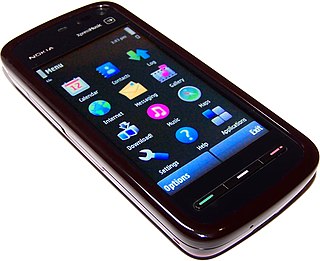
A smartphone is a mobile device that combines the functionality of a traditional mobile phone with advanced computing capabilities. It typically has a touchscreen interface, allowing users to access a wide range of applications and services, such as web browsing, email, and social media, as well as multimedia playback and streaming. Smartphones have built-in cameras, GPS navigation, and support for various communication methods, including voice calls, text messaging, and internet-based messaging apps.

A pedometer, or step-counter, is a device, usually portable and electronic or electromechanical, that counts each step a person takes by detecting the motion of the person's hands or hips. Because the distance of each person's step varies, an informal calibration, performed by the user, is required if presentation of the distance covered in a unit of length is desired, though there are now pedometers that use electronics and software to determine how a person's step varies automatically. Distance traveled can be measured directly by a GPS receiver.

The Nokia N79 is a Symbian OS v9.3 mobile phone and a member of the Nokia Nseries multimedia smartphone family running on S60 3rd Edition Feature Pack 2. It was officially announced by Nokia on 26 August 2008. The N79 is an advanced device with a 5 megapixel camera, dual LED flash, and GPS, with many improvements over the Nokia N78. It retailed for 350 euros upon release in October 2008.

The Nokia N95 is a mobile phone produced by Nokia as part of their Nseries line of portable devices. Announced in September 2006, it was released to the market in March 2007. The N95 ran S60 3rd Edition, on Symbian OS v9.2. It has a two-way sliding mechanism, which can be used to access either media playback buttons or a numeric keypad. It was first released in silver and later on in black, with limited edition quantities in gold and purple. The launch price of the N95 was around €550.
A mobile operating system is an operating system used for smartphones, tablets, smartwatches, smartglasses, or other non-laptop personal mobile computing devices. While computers such as typical/mobile laptops are "mobile", the operating systems used on them are generally not considered mobile, as they were originally designed for desktop computers that historically did not have or need specific mobile features. This line distinguishing mobile and other forms has become blurred in recent years, due to the fact that newer devices have become smaller and more mobile unlike hardware of the past. Key notabilities blurring this line are the introduction of tablet computers, light-weight laptops, and the hybridization of the two in 2-in-1 PCs.

Windows Phone (WP) is a discontinued mobile operating system developed by Microsoft for smartphones as the replacement successor to Windows Mobile and Zune. Windows Phone featured a new user interface derived from the Metro design language. Unlike Windows Mobile, it was primarily aimed at the consumer market rather than the enterprise market.

A satellite navigation device, satnav device or satellite navigation receiver is a user equipment that uses one or more of several global navigation satellite systems (GNSS) to calculate the device's geographical position and provide navigational advice. Depending on the software used, the satnav device may display the position on a map, as geographic coordinates, or may offer routing directions.

Nokia 5800 XpressMusic is a smartphone part of the XpressMusic line, announced by Nokia on 2 October 2008 in London and started shipping in November of that year. Code-named "Tube", it was the first touchscreen-equipped S60 device by Nokia – essentially it was the first device to run Symbian^1, also known as S60 5th Edition, the touch-specific S60-based platform created by the Symbian Foundation. The touchscreen features tactile feedback.

Here Technologies is a Dutch multinational group specialized in mapping technologies, location data and related automotive services to individuals and companies. It is majority-owned by a consortium of German automotive companies and American semiconductor company Intel whilst other companies also own minority stakes. Its roots date back to U.S.-based Navteq in 1985, which was acquired by Finland-based Nokia in 2007. Here is currently based in The Netherlands.
The W3C Geolocation API is an effort by the World Wide Web Consortium (W3C) to standardize an interface to retrieve the geographical location information for a client-side device. It defines a set of objects, ECMAScript standard compliant, that executing in the client application give the client's device location through the consulting of Location Information Servers, which are transparent for the application programming interface (API). The most common sources of location information are IP address, Wi-Fi and Bluetooth MAC address, radio-frequency identification (RFID), Wi-Fi connection location, or device Global Positioning System (GPS) and GSM/CDMA cell IDs. The location is returned with a given accuracy depending on the best location information source available.

The Motorola Cliq is an Android-based smartphone by Motorola.

Symbian is a discontinued mobile operating system (OS) and computing platform designed for smartphones. It was originally developed as a proprietary software OS for personal digital assistants in 1998 by the Symbian Ltd. consortium. Symbian OS is a descendant of Psion's EPOC, and was released exclusively on ARM processors, although an unreleased x86 port existed. Symbian was used by many major mobile phone brands, like Samsung, Motorola, Sony Ericsson, and above all by Nokia. It was also prevalent in Japan by brands including Fujitsu, Sharp and Mitsubishi. As a pioneer that established the smartphone industry, it was the most popular smartphone OS on a worldwide average until the end of 2010, at a time when smartphones were in limited use, when it was overtaken by iOS and Android. It was notably less popular in North America.

A smartwatch is a portable and wearable computer device in a form of a watch; modern smartwatches provide a local touchscreen interface for daily use, while an associated smartphone app provides management and telemetry, such as long-term biomonitoring. While early models could perform basic tasks such as calculations, digital time telling, translations, and game-playing, smartwatches released since 2015 have more general functionality closer to smartphones, including mobile apps, a mobile operating system, and WiFi/Bluetooth connectivity. Some smartwatches function as portable media players, with FM radio and playback of digital audio and video files via a Bluetooth headset. Some models, called watch phones, have mobile cellular functionality such as making telephone calls.

The Nokia N9 is a flagship smartphone developed by Nokia, running on the Linux-based MeeGo mobile operating system. Announced in June 2011 and released in September, it was the first and only device from Nokia with MeeGo, partly because of the company's partnership with Microsoft announced that year. It was initially released in three colors: black, cyan and magenta, before a white version was announced at Nokia World 2011.

The Nokia X7-00 is a Symbian^3 smartphone from the Nokia Xseries. It is the first Xseries phone with Nokia's Symbian^3 platform and it shipped with the Anna update. It is also the successor to X6, which was the previous multimedia touchscreen phone, with similar features and specifications in the series. The X7-00 was announced on 12 April 2011, alongside the Nokia E6.

Recon Instruments was a Canadian technology company that produced smartglasses and wearable displays marketed by the company as "heads-up displays" for sports. Recon's products delivered live activity metrics, GPS maps, and notifications directly to the user's eye. Recon's first heads-up display offering was released commercially in October 2010, roughly a year and a half before Google introduced Google Glass.
Microsoft mobile services are a set of proprietary mobile services created specifically for mobile devices; they are typically offered through mobile applications and mobile browser for Windows Phone platforms, BREW, and Java. Microsoft's mobile services are typically connected with a Microsoft account and often come preinstalled on Microsoft's own mobile operating systems while they are offered via various means for other platforms. Microsoft started to develop for mobile computing platforms with the launch of Windows CE in 1996 and later added Microsoft's Pocket Office suite to their Handheld PC line of PDAs in April 2000. From December 2014 to June 2015, Microsoft made a number of corporate acquisitions, buying several of the top applications listed in Google Play and the App Store including Acompli, Sunrise Calendar, Datazen, Wunderlist, Echo Notification Lockscreen, and MileIQ.

The Samsung Galaxy Star is a low-end smartphone manufactured by Samsung Electronics. It is running on Android 4.1.2(Jelly Bean). It has unofficial Android 4.4, 5.1, 6.0.1 and 7.1 roms. It was announced in April 2013, it was subsequently released in May 2013. It is the cheapest smartphone in the Samsung Galaxy series. Like all other Samsung Galaxy smartphones, the Galaxy Star runs on the Android mobile operating system. The phone is available in 2 versions: a single SIM version (GT-S5280) and a dual SIM version (GT-S5282). The phone competes with other low-cost smartphones such as the smartphones from the Nokia Asha series as well as low-cost smartphones manufactured by Indian manufacturers such as Micromax, Karbonn, Spice Digital, Lava International and Celkon. It is available in certain Asian countries such as India, Pakistan, Sri Lanka, Nepal, Bangladesh, Myanmar, Philippines, Indonesia etc. where low-cost smartphones are very popular as well as in Morocco, Algeria, South Africa, Portugal, France, Germany, Russia and Ukraine. Brazilian version is also released, dubbed GT-S5283B.














